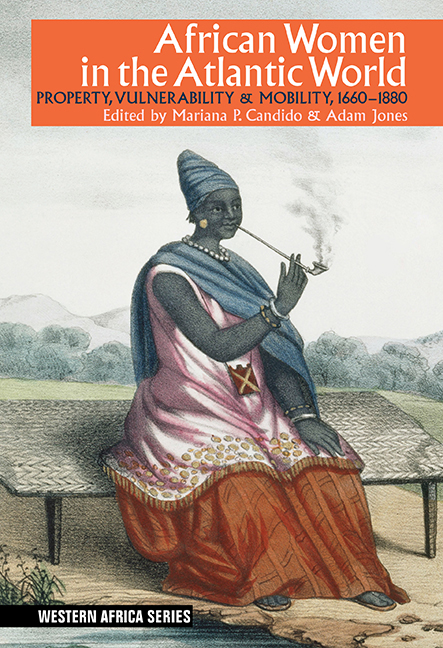Book contents
- Frontmatter
- Contents
- Acknowledgements
- List of Illustrations
- Contributors
- Map 1 Western Africa
- Introduction
- Part One Property
- 1 Adaptation in the Aftermath of Slavery Women, Trade & Property in Sierra Leone, c. 1790–1812
- 2 Women, Land & Power in the Lower Gambia River Region
- 3 Women & Food Production Agriculture, Demography & Access to Land in Late Eighteenth-Century Catumbela
- 4 Women's Material World in Nineteenth-Century Benguela
- Part Two Vulnerability
- Part Three Mobility
- Bibliography
- Index
2 - Women, Land & Power in the Lower Gambia River Region
from Part One - Property
Published online by Cambridge University Press: 26 March 2019
- Frontmatter
- Contents
- Acknowledgements
- List of Illustrations
- Contributors
- Map 1 Western Africa
- Introduction
- Part One Property
- 1 Adaptation in the Aftermath of Slavery Women, Trade & Property in Sierra Leone, c. 1790–1812
- 2 Women, Land & Power in the Lower Gambia River Region
- 3 Women & Food Production Agriculture, Demography & Access to Land in Late Eighteenth-Century Catumbela
- 4 Women's Material World in Nineteenth-Century Benguela
- Part Two Vulnerability
- Part Three Mobility
- Bibliography
- Index
Summary
Before the mid-nineteenth century, women in the lower Gambia River region appear to have had access to land, to a greater extent than in the late nineteenth century. While men controlled the millet and Guinea-corn fields, Mandinka women exercised influence over the control of rice-lands located in the swamps. This chapter will focus on women's shifting access to land and how this was linked to the transformation from food crop production to the cultivation of peanuts.
Throughout this chapter, I analyse instances where a few prominent women exercised some influence in land matters in the late eighteenth and the nineteenth centuries. Drawing on a wide range of oral sources, as well as information from travellers’ accounts and colonial records, I attempt to locate the life stories of three prominent women, Wuleng Jabbi Jarsey, Jebu Sonko and Fatou Jobba, in their wider networks of power, and discuss their ability to control land. Furthermore, the chapter stresses the important roles that Islam and spiritual beliefs in jinns and other spirits played in shaping power dynamics and mobility. These influenced the ability of people to access land and whether a certain site should be abandoned or settled. The chapter reveals, mostly through the stories of the three women, that family dynamics and not just gender influenced land access. Women who controlled the land and the labour of enslaved and poor dependants overturned patriarchal power and the ideology that perpetuated it.
Historical research on pre-colonial African women ‘landowners’ is still very limited. With regard to the Gambia, Isatou Touray has written on the concept of ownership in Mandinka societies. She contends that ‘traditionally, the Mandinka women’ were able to access land but they did ‘not own it’, yet overlooks the fact that Mandinka households held land under two broad forms. Michael Watts has identified the collective (maruo) fields, usually under the control of male heads (the korrdaatiyolu), on which family members were expected to work to provide domestic subsistence and the individual fields the Mandinka called kamanyango. The household or kabilo heads granted family members the plots they used. Mandinka women cultivated rice on both the individual and collective fields, and swamp clearance usually conferred ownership (see Map 3).
- Type
- Chapter
- Information
- African Women in the Atlantic WorldProperty, Vulnerability & Mobility, 1660–1880, pp. 38 - 54Publisher: Boydell & BrewerPrint publication year: 2019

